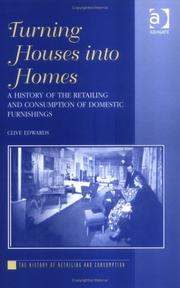| Listing 1 - 3 of 3 |
Sort by
|

ISBN: 0754609065 Year: 2005 Publisher: Aldershot Ashgate
Abstract | Keywords | Export | Availability | Bookmark
 Loading...
Loading...Choose an application
- Reference Manager
- EndNote
- RefWorks (Direct export to RefWorks)
History of the United Kingdom and Ireland --- History of civilization --- anno 1700-1799 --- anno 1800-1999 --- House furnishings industry and trade --- Ameublement --- History. --- Industrie --- Histoire --- Home furnishings industry and trade --- Housefurnishings industry and trade --- Manufacturing industries --- History

ISBN: 0191919292 1281345849 9786611345846 0191532622 1435610032 9781435610033 9780191532627 9780199264537 0199264538 0199264538 9780191919299 Year: 2005 Publisher: Oxford New York Oxford University Press
Abstract | Keywords | Export | Availability | Bookmark
 Loading...
Loading...Choose an application
- Reference Manager
- EndNote
- RefWorks (Direct export to RefWorks)
In 'Gold and Gilt, Pots and Pins', David Hinton looks at what possessions meant to people at every level of society in Britain in the Middle Ages, from elaborate gold jewellery to clay pots, and provides a fascinating window into the society of the Middle Ages.
Personal belongings --- Dress accessories --- House furnishings --- Middle Ages. --- Home furnishings --- Household goods --- Home economics --- Interior decoration --- Accessories (Dress) --- Costume accessories --- Fashion accessories --- Clothing and dress --- Belongings, Personal --- Bundles of personal belongings --- Effects, Personal --- Paraphernalia, Personal --- Personal effects --- Personal paraphernalia --- Personal possessions --- Possessions, Personal --- Dark Ages --- History, Medieval --- Medieval history --- Medieval period --- Middle Ages --- World history, Medieval --- World history --- Civilization, Medieval --- Medievalism --- Renaissance --- History --- Equipment and supplies --- Great Britain --- Antiquities. --- Social life and customs --- Civilization --- Material culture --- Culture --- Folklore --- Technology

ISBN: 0199264538 9780199264537 Year: 2005 Volume: *2 Publisher: Oxford Oxford University Press
Abstract | Keywords | Export | Availability | Bookmark
 Loading...
Loading...Choose an application
- Reference Manager
- EndNote
- RefWorks (Direct export to RefWorks)
"In medieval Britain people wore jewellery made of gold if they were rich, of base metal if they were poor; they might hoard their property, or give it away to guarantee that they would have friends when needed; and many of them paid tax on their possessions. In Gold and Gilt, Pots and Pins David Hinton reviews the significance of artefacts in this period. From elaborate gold jewellery to clay pots, he looks at what possessions meant to people at every level of society. His emphasis is on their reasons for acquiring, keeping, displaying, and disposing of the things that they wore and had in their houses." "An overall review that looks at evidence in Scotland and Wales as well as in England, this book ranges chronologically from the end of the Roman rule of Britain to the introduction of the new modes and practices that are usually termed 'Renaissance', marked by the changes in religion. Lavishly illustrated, the author provides an illuminating window into the society of the Middle Ages."--Jacket. "Drawing on a wide range of physical and documentary evidence, including objects from archaeological excavations and written sources, he argues that the significance of material culture has not been properly taken into account in explanations of social change, particularly in the later Middle Ages. He also explores how identity was created, and how social division was expressed and reinforced."
Dress accessories --- House furnishings --- Material culture --- Personal belongings --- Belongings, Personal --- Bundles of personal belongings --- Effects, Personal --- Paraphernalia, Personal --- Personal effects --- Personal paraphernalia --- Personal possessions --- Possessions, Personal --- Culture --- Folklore --- Technology --- Home furnishings --- Household goods --- Home economics --- Interior decoration --- Accessories (Dress) --- Costume accessories --- Fashion accessories --- Clothing and dress --- History --- Equipment and supplies --- Great Britain --- Antiquities. --- Civilization --- Antiquities --- Social life and customs --- 1066-1485 --- Betekenis. --- Bezit. --- Civilization. --- Dress accessories. --- Geschichte 1066-1485. --- House furnishings. --- Material culture. --- Materiële cultuur. --- Oberschicht. --- Personal belongings. --- Sachkultur. --- Schmuck. --- Sociale identiteit. --- Sozialstatus. --- To 1500. --- Great Britain. --- Gro�britannien.
| Listing 1 - 3 of 3 |
Sort by
|

 Search
Search Feedback
Feedback About UniCat
About UniCat  Help
Help News
News